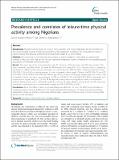| dc.description.abstract | Background: Physical inactivity levels are rising in many countries with major implications for the prevalence of non-communicable diseases and the general health of the population worldwide. We conducted this study to examine leisure-time physical activity levels among African adults in an urban setting. Methods: We conducted a cross-sectional study among a random sample of 1,058 adults at a government worksite, in Abuja, an urban Nigerian city. We used log-binomial regression models to estimate the multivariable-adjusted associations of correlates of physical activity. Results: The mean age of the study population was 42 ± 9.3 years, 60% were men and 40% were women. The mean metabolic equivalent hours per week for all the participants was 6.8 ± 7.2. In univariate analysis comparing the lowest to highest tertiles of physical activity, the prevalence ratio (PR) and (95% confidence interval, CI) was 0.95 (0.81-1.11) p = 0.49, comparing women to men; compared to those aged <30 years the PR (95% CI) was 0.70 (0.57-0.86), 0.70 (0.58-0.85) and 0.78 (0.63-0.96) for age 30–39, 40–49 and ≥50 years respectively, p for trend = 0.03; compared to those who were normal weight, the PR was 0.93 (0.79-1.10) and 0.90 (0.74-1.09) for overweight and obese persons respectively, p = 0.26. The PR for age was attenuated to non-significant levels in multivariable analyses. Being married was a statistically significant correlate of higher physical activity levels, the PR comparing unmarried to married persons in multivariate analysis was 0.81 (0.67-0.97), p = 0.03. Conclusions: More than 80% of urban, professional Nigerian adults do not meet the WHO recommendations of physical activity. Urbanized Africans in this study population had low levels of leisure-time physical activity, independent of age, sex and body-mass index. This has major implications for the prevalence of non-communicable diseases in this population. | en |


